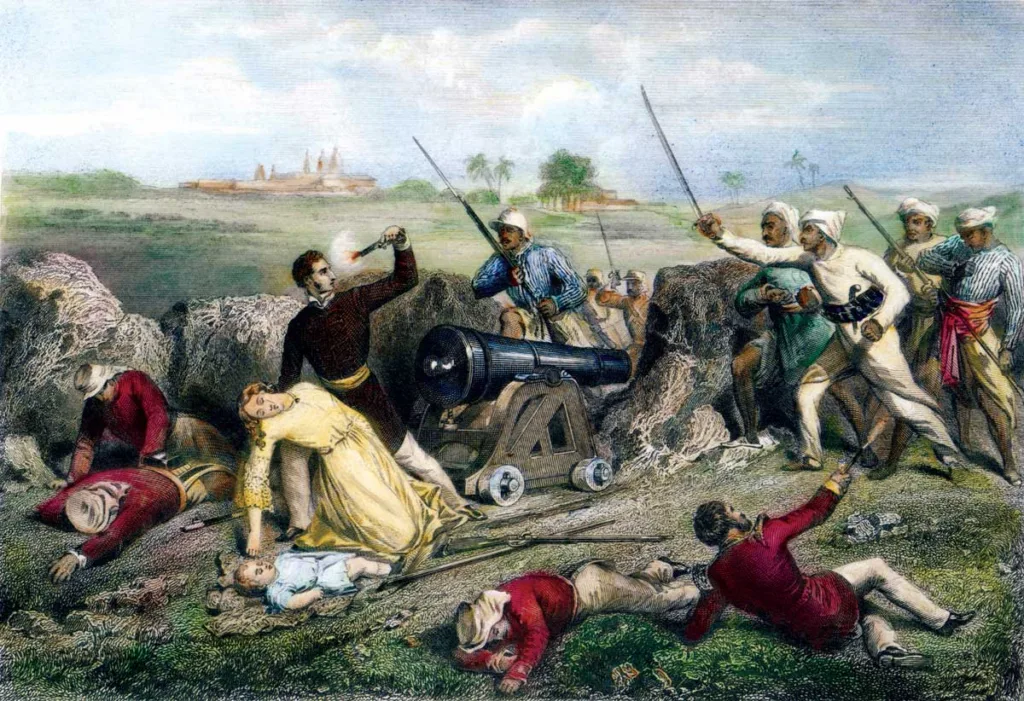The Sepoy Rebellion, also known as the Indian Mutiny or the First War of Indian Independence, was an important event in the history of India. The rebellion began in May 1857, when Indian soldiers, known as sepoys, mutinied against their British officers. The sepoys were angry at the British for a variety of reasons, including the use of animal fat on the cartridges they used for their rifles.
The rebellion quickly spread throughout northern and central India, with sepoys and civilians joining forces to fight against the British. The rebels were able to seize control of some towns and cities, but they were ultimately unsuccessful in their efforts to oust the British from India.
One of the main reasons why the Sepoy Rebellion was not successful was the lack of a clear leader or strategy among the rebels. While there were several leaders who emerged during the rebellion, they were not able to coordinate their efforts effectively. This lack of organization made it difficult for the rebels to mount a sustained offensive against the British.
Another factor that contributed to the failure of the rebellion was the overwhelming military superiority of the British. The British had access to far greater resources than the rebels, including troops, weapons, and supplies. Additionally, many Indian soldiers remained loyal to the British, especilly the Sikhs, who were largely unaffected by the cartridge issue.
Ultimately, the Sepoy Rebellion was put down by the British, with the help of additional troops that were shipped in from Europe. The rebellion had important consequences for India, however. It led to the end of the British East India Company’s rule in India and the establishment of direct British rule. It also sparked a renewed sense of Indian nationalism and a desire for independence that would grow stronger in the years to come.
While the Sepoy Rebellion was not successful in its goal of ousting the British from India, it was an important event that had significant consequences for the country. The rebellion highlighted the deep-seated grievances that many Indians had against British rule and paved the way for future movements for independence and self-rule.
What Was The Outcome Of The Sepoy Rebellion?
The outcome of the Sepoy rebellion, also known as the Indian Mutiny or the First War of Indian Independence, was a significant shift in the British administration of India. The British parliament held the East India Company responsible for the excesses that led to the mutiny, resulting in the transfer of power from the Company to the British Crown. The British government abolished the East India Company, and India became a British colony. The rebellion also led to the end of the Mughal Empire, as Bahadur Shah Zafar, the last Mughal emperor, was exiled to Rangoon. The British implemented several administrative and policy reforms to prevent future uprisings, including the recruitment of more Indian soldiers, the introduction of more Indian representation in the administration, and the implementation of the Doctrine of Lapse to expand British control over Indian states. the Sepoy rebellion had a significant impact on Indian history and the British Empire’s rule in India.

Who Won The Sepoy Rebellion?
The Sepoy Rebellion of 1857-8, also known as the Indian Mutiny, was a major uprising against British rule in India. The British East India Company ultimately emerged victorious in the conflict. The Company was able to defeat the rebels due to its significant resources, including the loyalty of many of its Indian troops, particularly the Sikhs. Additionally, the Company was able to bring in 40,000 British soldiers from Europe to aid in the conflict. Despite the Rebellion’s initial successes, the British were ultimately able to suppress the uprising and maintain control over India.
Is The Revolt Of 1857 Was Success?
The revolt of 1857, also known as the Indian Rebellion of 1857, was an uprising against British rule in India. While the revolt did manage to gain some initial success in certain regions, it ultimately failed to oust the British from the country.
There were sevral reasons for the failure of the revolt. Firstly, the sepoys, or Indian soldiers, lacked a clear leader to rally behind. There were several leaders vying for control, which led to confusion and disunity among the rebels.
Additionally, the rebels did not have a coherent plan for how to defeat the British. They were not able to coordinate their efforts effectively, and as a result, many of their attacks were poorly executed and unsuccessful.
Furthermore, the British were able to quell the rebellion with their superior military strength and resources. They were able to bring in reinforcements from other parts of their empire, which tipped the balance of power in their favor.
While the revolt of 1857 did manage to create some unrest and challenge British rule in India, it ultimately failed to achieve its main goal of ousting the British from the country.
Conclusion
The Sepoy Rebellion, also known as the Indian Mutiny, was a significant event in Indian history that took place in 1857. It was a result of various political, economic and religious factors that led to a widespread uprising against the British East India Company. The rebellion was primarily led by Indian soldiers or sepoys, who were unhappy with the British policies and practices. Although the rebellion was unsuccessful in driving the British out of India, it did have far-reaching consequences. It led to the end of the East India Company’s rule and the beginning of the British Raj. The rebellion also sparked a renewed sense of Indian nationalism and paved the way for the Indian independence movement in the fllowing decades. the Sepoy Rebellion was a pivotal moment in Indian history that had significant long-term effects on the country’s political, social and cultural landscape.
